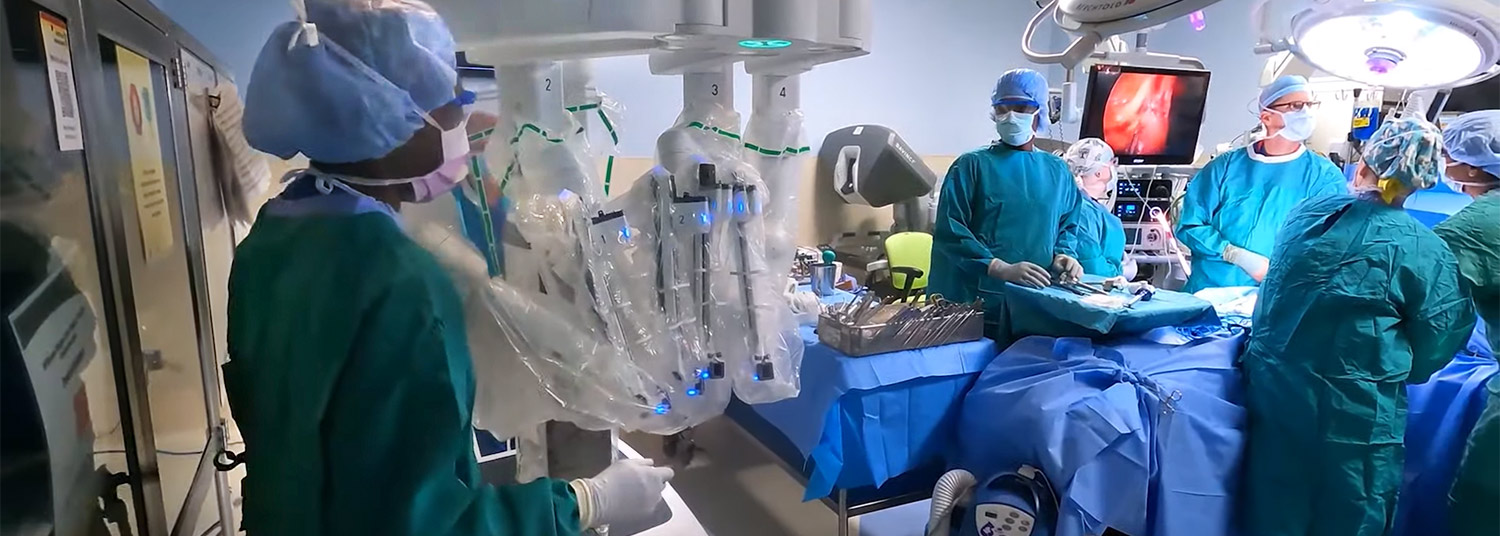March 14, 2022 | Bill Seiler
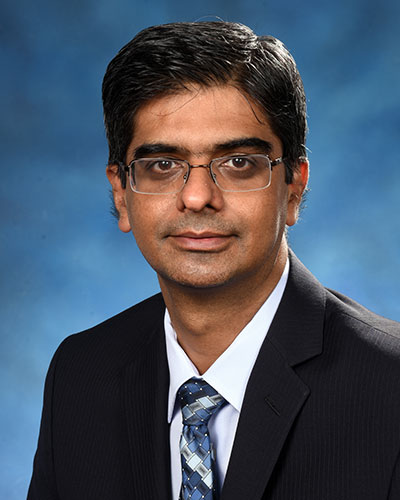 Innovative Surgery Performed at the University of Maryland Medical Center Promises Reduced Hospital Stay and New Options for Obese Patients
Innovative Surgery Performed at the University of Maryland Medical Center Promises Reduced Hospital Stay and New Options for Obese Patients
Chandra S. Bhati, MS, MBBS, Professor of Surgery at the University of Maryland School of Medicine, became the first transplant surgeon in the state to use robot-assisted surgery to transplant a kidney from a living donor. He performed the surgery in September at the University of Maryland Medical Center (UMMC) and has performed several successful transplants since then using the minimally invasive technique.
The technology enables smaller incisions to perform the transplant, which often leads to a quicker recovery with less pain and scarring than a traditional transplant. It also presents fewer risks for obese patients, which could expand the list of patients eligible to receive a transplant.
The first patient, 36-year-old Omelia Bennett of Randallstown, had been on dialysis for seven years as she waited for a matching donor. When a living donor became available, she jumped at the option of having a less invasive surgery with robotic technology that offered a faster recuperation time and fewer days in the hospital.
 "I just want to start my life over again, and if I could have a surgery which minimizes scarring, I was up for it," said Ms. Bennett. She received the transplant on a Thursday. "The next day, at 4 o'clock in the morning, I was walking around. I wasn't in that much pain." She went home from the hospital the following Monday, just five days after her transplant.
"I just want to start my life over again, and if I could have a surgery which minimizes scarring, I was up for it," said Ms. Bennett. She received the transplant on a Thursday. "The next day, at 4 o'clock in the morning, I was walking around. I wasn't in that much pain." She went home from the hospital the following Monday, just five days after her transplant.
"This minimally invasive, robot-assisted approach to transplant has several advantages. It improves a surgeon's precision through the use of computer and software technology to assist with complex tasks in confined areas of the body, and only requires small incisions that leave about a two-inch scar just above the belly button, and three or four smaller scars, each about a third of an inch," said Dr. Bhati, a UMMC transplant surgeon who directed the robot during Ms. Bennett's procedure. "A traditional open transplant, on the other hand, requires a 6- to 8-inch incision through abdominal muscle. Having smaller incisions leads to faster recovery, less pain, and reduced chance of wound complications," said Dr. Bhati.
Advances in Kidney Transplantation
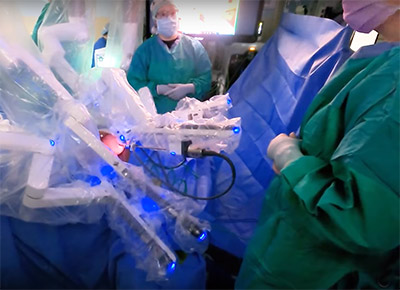 Surgical improvements on the living donor side of kidney transplantation have led to minimally invasive, laparoscopic removal of a kidney through the donor's navel or belly button. The surgeon uses a tiny camera called a laparoscope to see inside the patient's body and manipulates hand-held instruments inserted through the navel to perform the surgery.
Surgical improvements on the living donor side of kidney transplantation have led to minimally invasive, laparoscopic removal of a kidney through the donor's navel or belly button. The surgeon uses a tiny camera called a laparoscope to see inside the patient's body and manipulates hand-held instruments inserted through the navel to perform the surgery.
Robot-assisted transplantation brings minimally invasive techniques to the recipient. In this case, a surgeon-controlled robotic device holds the laparoscope and instruments. The surgeon sits at a computer console located across the room from the patient and directs the movements of robotic arms, a camera and tiny surgical instruments about the size of a fingernail, inserted through small incisions in the abdomen to implant the donor kidney. The computer connection facilitates precise ergonomic control of the instruments, and the camera provides a magnified 3D view--more detailed than the traditional 2D laparoscopic view.
More options for obese patients
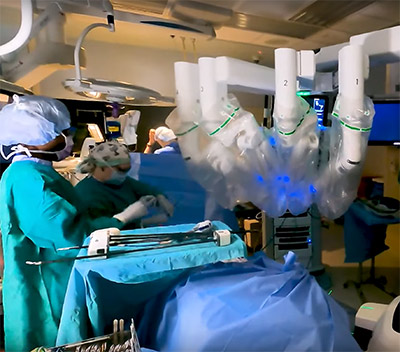 Robotic techniques may also increase the number of patients eligible for kidney transplants, according to Dr. Bhati. Many transplants centers in the U.S. deny access to kidney transplantation for obese patients with a body mass index over 35, out of concern for increased complications during and after open surgery. "The larger the patient, the larger the scar, because with open surgery, we have to reach all the way to the lower portion of the abdomen to place the kidney. With the robot's extended reach through tiny openings, complications related to scarring and healing are reduced, and we can offer a transplant to those who would not normally qualify because of their excess body weight," said Dr. Bhati.
Robotic techniques may also increase the number of patients eligible for kidney transplants, according to Dr. Bhati. Many transplants centers in the U.S. deny access to kidney transplantation for obese patients with a body mass index over 35, out of concern for increased complications during and after open surgery. "The larger the patient, the larger the scar, because with open surgery, we have to reach all the way to the lower portion of the abdomen to place the kidney. With the robot's extended reach through tiny openings, complications related to scarring and healing are reduced, and we can offer a transplant to those who would not normally qualify because of their excess body weight," said Dr. Bhati.
Robotic tools have long been used at UMMC for various surgical procedures, including for removal of donor kidneys, and in cardiac, gynecological, urological, pediatric and head and neck procedures, as well as spinal and oral and maxillofacial surgery.
In the wake of Ms. Bennett's Maryland milestone, several other patients with kidney failure have also successfully received new living-donor kidneys through UMMC's robot-assisted approach. One patient was obese and would not have qualified for a traditional open transplant in light of the risks.
"Robotic-assisted surgery in living donor kidney transplantation promises to be a safe alternative to open surgery, especially for obese patients with end-stage kidney disease," said E. Albert Reece, MD, PhD, MBA, Executive Vice President for Medical Affairs, UM Baltimore, and the John Z. and Akiko K. Bowers Distinguished Professor and Dean, University of Maryland School of Medicine. "This expanded use of robotic tools in transplantation is an example of our faculty's ongoing mission to research and introduce new techniques to enhance patient care and safety."
About the University of Maryland Medical Center
The University of Maryland Medical Center (UMMC) is comprised of two hospital campuses in Baltimore: the 800-bed flagship institution of the 13-hospital University of Maryland Medical System (UMMS) and the 200-bed UMMC Midtown Campus. Both campuses are academic medical centers for training physicians and health professionals and for pursuing research and innovation to improve health. UMMC's downtown campus is a national and regional referral center for trauma, cancer care, neurosciences, advanced cardiovascular care, women's and children's health, and has one of the largest solid organ transplant programs in the country. The world's first successful pig-to-human heart xenotransplant was performed at UMMC. All physicians on staff at the downtown campus are clinical faculty physicians of the University of Maryland School of Medicine. The UMMC Midtown Campus medical staff is predominately faculty physicians specializing in a wide spectrum of medical and surgical subspecialties, primary care for adults and children and behavioral health. UMMC Midtown has been a teaching hospital for 140 years and is located one mile away from the downtown campus. For more information, visit www.umm.edu
About the University of Maryland School of Medicine
Now in its third century, the University of Maryland School of Medicine was chartered in 1807 as the first public medical school in the United States. It continues today as one of the fastest growing, top-tier biomedical research enterprises in the world -- with 46 academic departments, centers, institutes, and programs, and a faculty of more than 3,000 physicians, scientists, and allied health professionals, including members of the National Academy of Medicine and the National Academy of Sciences, and a distinguished two-time winner of the Albert E. Lasker Award in Medical Research. With an operating budget of more than $1.3 billion, the School of Medicine works closely in partnership with the University of Maryland Medical Center and Medical System to provide research-intensive, academic and clinically based care for nearly 2 million patients each year. The School of Medicine has nearly $600 million in extramural funding, with most of its academic departments highly ranked among all medical schools in the nation in research funding. As one of the seven professional schools that make up the University of Maryland, Baltimore campus, the School of Medicine has a total population of nearly 9,000 faculty and staff, including 2,500 students, trainees, residents, and fellows. The combined School of Medicine and Medical System (“University of Maryland Medicine”) has an annual budget of over $6 billion and an economic impact of nearly $20 billion on the state and local community. The School of Medicine, which ranks as the 8th highest among public medical schools in research productivity (according to the Association of American Medical Colleges profile) is an innovator in translational medicine, with 606 active patents and 52 start-up companies. In the latest U.S. News & World Report ranking of the Best Medical Schools, published in 2021, the UM School of Medicine is ranked #9 among the 92 public medical schools in the U.S., and in the top 15 percent (#27) of all 192 public and private U.S. medical schools. The School of Medicine works locally, nationally, and globally, with research and treatment facilities in 36 countries around the world. Visit medschool.umaryland.edu
Contact
Bill Seiler
Media Relations Assistant Director
UMMC – Transplant, Heart and Vascular, Surgery
Office: 410-328-7651
Cell: 410-913-8464
bseiler@umm.edu
Related stories
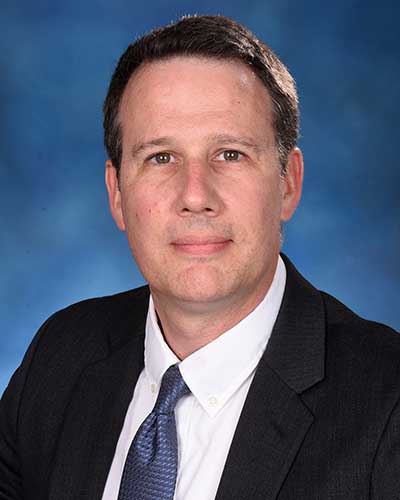
Monday, December 16, 2024
Researchers Discover New Neurons that Suppress Food Intake
Obesity affects a staggering 40 percent of adults and 20 percent of children in the United States. While some new popular therapies are helping to tackle the epidemic of obesity, there is still so much that researchers do not understand about the brain-body connection that regulates appetite. Now, researchers have discovered a previously unknown population of neurons in the hypothalamus that regulate food intake and could be a promising new target for obesity drugs.

Friday, June 24, 2016
Surgical First: Patient Avoids Dialysis Thanks to Simultaneous Polycystic Kidney Removal and Kidney Transplant During 28-Person Kidney Swap
In a first-of-its-kind procedure in the United States, a patient was able to avoid dialysis when surgeons simultaneously removed two diseased kidneys and also transplanted a kidney from a living donor – all as part of a 28-person paired kidney exchange (PKE). The procedure, performed in May on a patient with polycystic kidney disease (PKD), eliminated the need for the patient to ever undergo dialysis.

